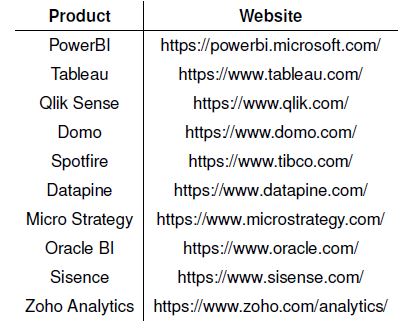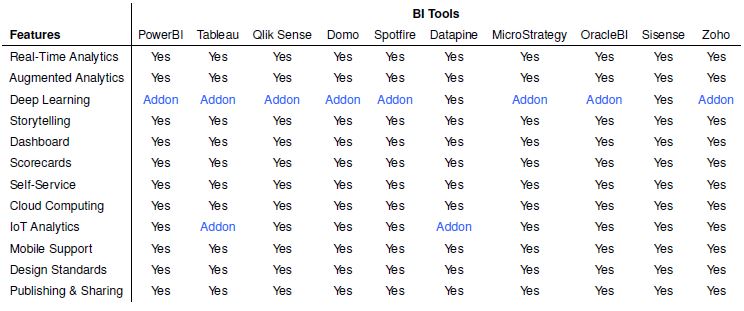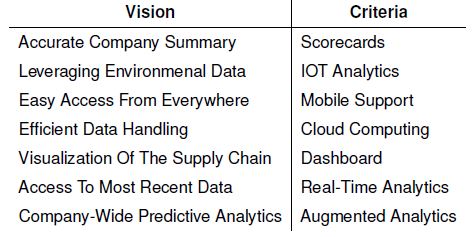The idea of supporting management with the help of electronic information systems has a long history, with the first basic systems emerging in the nineteen sixties. After several unsatisfactory early attempts, twenty years later the first working systems were established. These systems called Management Support Systems ultimately lead to the modern Business Intelligence systems, which came to be in the nineteen nineties. Thereby understanding of the term Business Intelligence (BI) refers to an integrated, information technology-based decision support system that is specifically adapted to a certain company.
Initially, BI encompassed software modules for queries and reporting. Over time more sophisticated functionality like online analytical processing, tools for data visualization, and support for mobile devices has been added. These added features are thereby meant to help the end-users control the complex BI solutions.
Given that data acquisition and storage is less expensive than it ever was before, businesses are trying to leverage massive volumes of data with ever-decreasing granularity. This increased need for BI solutions that can handle modern-day requirements has led to a massive growth of products that try to satisfy these requirements.
There are many BI tools available that transform raw data into meaningful and useful information. These tools all have their various uses and selection criteria. This project is thereby motivated as a result of the need to choose the right and most effective solution from the variety of BI tools available today.
To facilitate the choice, we will create a criteria catalog for the precise selection of BI tools that are suitable for an organization’s respective requirements. A criteria catalog is thereby an evaluation tool that allows for a standardized and simple assessment of a system, software, or something similar.
Feature Research
For the creation of the catalog, we will start with a literature review and extract relevant features for modern BI solutions, although we will lay our focus on the reporting and visualization capabilities. Thereby reporting can be defined as the preparation and analysis of data with the goal to generate insights. Following is a comprehensive list of required features for current BI tools:
- Support for Mobile Devices: BI tools should support mobile devices, touch operations, and provide rich interactivity. The user should be able to analyze data with a mobile device.
- Real-time Analytics: Real-time analytics should be supported to ensure that no outdated information is used for analysis.
- Publishing and Sharing of Analysis Content: Users should be able to publish and distribute content across departments through various file types and distribution methods.
- Dashboard: Dashboards should be an integral part of BI solutions. Thereby dashboards are used to reveal performance and obstacles in an organization.
- Data Storytelling: For better presentation of analysis insights, BI solutions should employ features for storytelling. The communication of findings can be vastly enhanced by supporting it with visuals and narrative.
- Cloud Computing: Given that a large part of data-related computation has been moved to the cloud, BI tools should support cloud computing.
- Self-Service Analytics: A BI solution should facilitate self-service analytics because the capability to gain valuable insights for business users of all levels becomes ever more important. To enable self-service analytics, BI tools should offer the possibility for a simplified and scaled-down data model with minimum analytic capabilities.
- Visual Design Standards: Visual design standards refer to the effective and appealing presentation of important information. Given the increasing amount of data to be analyzed and visualized, visual design standards start to gain massive importance.
- Internet-of-Things (IoT) Analytics: The number of connected devices and thereby the size of the IoT is increasing every year. These devices generate vast amounts of data that hold hidden value in the form of undiscovered information. To generate value from this information, BI solutions should provide support for IoT analytics.
- Scorecards: Scorecards are a possibility for summarizing and displaying key performance indicators, productivity, and satisfaction in an organization. The use of scorecards allows for better decision-making and should be integrated into every BI tool.
- Augmented Analytics: With the support of augmented analytics, BI tools can provide automated data preparation and the generation of insights. Thereby augmented analytics are realized with modern machine learning methods.
- Deep Learning: To further enhance analytics and to provide valuable insights faster, BI tools should incorporate deep learning-powered analytics. This also allows us to solve complex problems and also adds support for speech recognition.
Criteria Catalog and Product Research
With the list of the researched features, we can develop a general criteria catalog with twelve possible values:

In addition to the research and analysis of market requirements, we will look at the following currently offered BI solutions:

If we now apply our criteria catalog to the ten products we get the product catalog shown in the table below. The catalog lists the researched products and visualizes their capabilities regarding the general criteria catalog. Thereby the product catalog supplements the criteria catalog and facilitates the selection of the most suitable BI solution.

As can be seen in the product catalog, practically all of the software solutions natively support the researched features. Although some BI solutions do not have built-in support for features like deep learning and IoT analytics, these features can be added by leveraging third-party solutions, for example, Python.
Selecting a BI Tool
BI initiatives are notoriously difficult to implement and often fail. The reason for failure is that often the implementation is only viewed from a technological perspective. To alleviate this issue, it is important to define a strategy that connects the technological and non-technological aspects of the BI initiative.
A BI strategy consists of three distinct parts. The first element is the Vision, which is concerned with the reason why the BI initiative came to be in the first place. The second part is the people and processes part, which asks the question of who will execute the strategy and what are the processes. And for the last element, there are tools and architectures which determine the actual software solutions and how they will impact a certain part of the organization.
To showcase the selection process with the help of our criteria catalog, we will look at the use case of a fictional logistics company. Logistics companies are generally suitable for demonstration, as the transportation industry is a common field for the application of BI software.
Vision
As already explained, a BI strategy should be implemented with a clear vision in mind. In the case of the fictional logistics company, the vision could contain the following points:
- Accurate representation of the current state of the company
- Employing environmental data for optimizing operations
- Easy access to company data and analytics from everywhere
- Efficient handling of vast amounts of generated data
- Visualization of the supply chain and key metrics
- Access to the most recent data
- Predictive analytics for every part of the organization
Processes
In the case of the logistics company, a BI initiative that spans the whole organization encompasses a variety of different departments, executives, and processes. Following is a list of departments and their respective processes inside our logistics company that can be impacted by a BI solution.
- Transportation Management: Transportation management is concerned with various analytics and planning tasks, with all of these tasks benefiting from a BI solution. Thereby processes include capacity planning, cycle time analysis, and optimization of routes.
- Warehouse Management: Warehouse management is another integral part of a logistics company. Here possible processes encompass for example space utilization analysis and inventory analysis.
- Value-Added Services: To supplement transportation and warehouse management logistics companies offer value-added services which can be optimized with BI solutions. There are reverse logistics that are concerned with handling returns, kitting, or cost-benefit analysis.
- Information Technology Services: With BI solutions existing information infrastructure can be leveraged. Thereby a possible process is the development of supply and demand forecasting models for optimizing the logistics network
- Corporate Management: Corporate management refers to the top management of a company. Here the use of dashboards to effectively communicate key performance indicators is one of the possible use cases for a BI solution.
- Marketing and Sales: The marketing and sales department could benefit from various metrics which can be derived from processes like customer profitability analysis or customer service level analysis.
- Human Resources: The employment of a BI initiative in this department allows for the optimized allocation of personnel and the generation of reports to get an overview of the workforce.
- Financial Management: To aid financial management, processes like budgetary analysis and financial analysis, in general, can be supported by a suitable BI solution.
Tools
The final part of the BI initiative is the selection of suitable tools. In our case, the selection of the appropriate tools can be made by comparing the individual points of the vision to the general criteria catalog. Now with the derived criteria, the next step is to choose a suitable tool from the product catalog which matches the criteria as closely as possible.

When we look at our product catalog, it becomes visible that practically all solutions are suitable. From these findings, it can be derived that all of the researched products satisfy modern requirements. Nonetheless in this particular use case, a product with built-in support for IoT analytics would be the best choice. Therefore possible products would be all but Tableau and Datapine.
References
Allio, M. K. (2012). Strategic dashboards: designing and deploying them to improve implementation. Strategy & Leadership, 40(5), 24–31.
AltexSoft. (2020). Business intelligence strategy: How to develop and document your bi roadmap. Retrieved from https://www.altexsoft.com/blog/business-intelligence-strategy/
Boyer, J., Frank, B., Green, B., Harris, T., & van de Vanter, K. (2010). Business intelligence strategy: A practical guide for achieving bi excellence. Ketchum-Idaho: MC Press.
Chaudhuri, S., Dayal, U., & Narasayya, V. (2011). An overview of business intelligence technology. Communications of the ACM, 54(8), 88–98.
Chee, T., Chan, L.-K., Chuah, M.-H., Tan, C.-S., Wong, S. F., & Yeoh,W. (2009). Business intelligence systems: State-of-the-art review and contemporary applications. In Symposium on Progress in Information and Communication Technology.
Dedi´c, N., & Stanier, C. (2016). Measuring the success of changes to existing business intelligence solutions to improve business intelligence reporting. Research and Practical Issues of Enterprise Information Systems, 225–236.
Gartner. (2018). Gartner says self-service analytics and bi users will produce more analysis than data scientists will by 2019. Retrieved from https://www.gartner.com/en/newsroom/press-releases/2018-01-25-gartner-says-self-service-analytics-and-bi-users-will-produce-more-analysis-than-data-scientists-will-by 2019
Gartner. (2021). Definition of augmented analytics - gartner information technology glossary. Retrieved from https://www.gartner.com/en/information-technology/glossary/augmented-analytics
Habibu, T. (2013). Parallel data analytics for business intelligence real-time online analytical processing (olap) for multi-core and cloud architectures. Retrieved from https://www.researchgate.net/publication/319458909 Parallel Data Analytics for Business Intelligence Real-Time Online Analytical Processing OLAP For Multi-Core and Cloud Architectures
Kemper, H.-G., Baars, H., & Mehanna, W. (2010). Business intelligence - grundlagen und praktische anwendungen: Eine einf ¨uhrung in die it-basierte managementunterst¨utzung (3rd ed.). Wiesbaden: Vieweg+Teubner Verlag / GWV Fachverlage GmbH.
Llave, M. R. (2017). Business intelligence and analytics in small and medium-sized enterprises: A systematic literature review. Procedia Computer Science, 121, 194–205.
Niegemann, H. M., Domagk, S., Hessel, S., Hein, A., Hupfer, M., & Zobel, A. (2008). Kompendium multimediales lernen. Berlin and Heidelberg: Springer.
Pribisali´c, M., Jugo, I., & Martinˇci´c-Ipˇsi´c, S. (2019). Selecting a business intelligence solution that is fit for business requirements. Humanizing technology for a sustainable society, 443–465.
Qlik. (2021). Business intelligence reporting: A complete guide. Retrieved from https://www.qlik.com/us/business-intelligence/business-intelligence-reporting
Sharma, K., Shetty, A., Jain, A., & Dhanare, R. K. (2021). A comparative analysis on various business intelligence (bi), data science and data analytics tools. International Conference on Computer Communication International Conference on Computer Communication and Informatics (ICCCI), 1–11.
Srinivasa Rao, P., & Swarup, S. (2001). Business intelligence and logistics. Wipro Technologies.
Srivastava, G., S, M., Venkataraman, R., V, K., & N, P. (2021). A review of the state of the art in business intelligence software. Enterprise Information Systems, 1–28.
Stipi´c, A., & Bronzin, T. (2011). Mobile bi: The past, the present and the future. Proceedings of the 34th International Convention MIPRO, 1560–1564.
